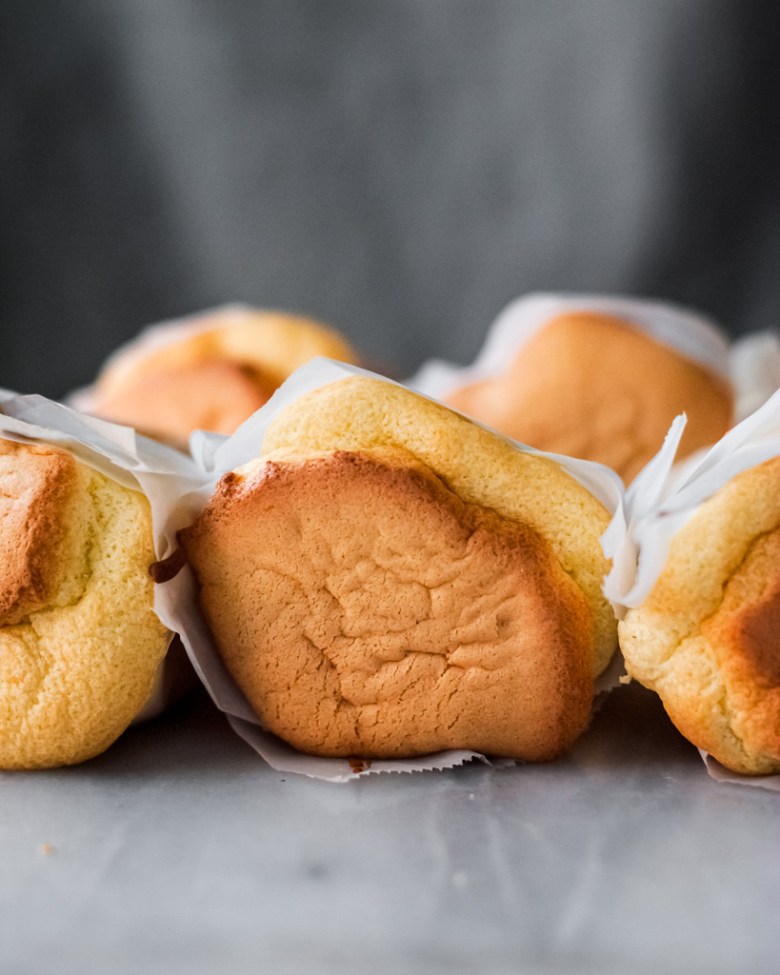Note: This post may contain affiliate links.

If you’re a fan of Asian ASMR YouTube channels, you’ve probably encountered some version of double fromage cheesecake over the years. Popularized by Japanese bakery chain LeTAO, double fromage cheesecake is made up of a sponge cake layer, topped with a layer of baked cheesecake, topped with a layer of cheesecake mousse (or no-bake cheesecake). Once set, the entire cake is dusted with leftover sponge cake crumbs. As with many Asian-style cakes it’s light and lightly sweetened — perfect for warm summer evenings.
LeTAO has actually shared their original recipe on YouTube (it’s in Japanese, but you can get a general idea from the subtitles). With their recipe as a guideline, I created this strawberry version by adding a layer of strawberry gelee between the two cheesecakes and strawberry puree to the cheesecake mousse. To pack a stronger strawberry punch, the whole cake is lightly frosted with strawberry whipped cream and strawberry-speckled cake crumbs (strawberry shortcake Good Humor bar vibes, anyone?).
This strawberry double fromage cheesecake isn’t hard to make, but it does take some time for the different layers to set. You can make it leisurely over one day, or break up the work over a couple days to fit your schedule.

Baker’s Notes:
- You’ll need strawberry puree for the strawberry gelee and strawberry cheesecake mousse layers. I made my own by simply whizzing up some fresh strawberries in a blender, but you can use store-bought puree or use frozen berries (thaw before blending). I like to strain my puree to get rid of the seeds, so I always start with 50% more berries (by weight) than what I need for the recipe. (In this case, I suggest starting with 225g fresh strawberries). Freeze any extras for a later use, or just toss into your next smoothie or swirl into yogurt!
- I absolutely love the flavor combination of strawberries and elderflower, so I used some IKEA elderflower syrup in both the gelee and mousse. You could use another brand or even elderflower liqueur (like St-Germain). No biggie if you don’t have it, though — subs are in the recipe!

Strawberry Double Fromage Cheesecake
Makes one 6″ cake | Adapted from LeTAO and Baked to Order
Ingredients:
For the sponge cake:
- 45g milk
- 30g neutral oil (I used grapeseed)
- 1/8 tsp kosher salt
- 1/2 tsp vanilla extract
- 3 large eggs, separated (cold is fine)
- 1/4 tsp cream of tartar
- 75g granulated sugar, preferably caster or superfine
- 80g cake flour, sifted
For the baked cheesecake:
- 165g full-fat cream cheese, at room temperature
- 50g granulated sugar
- 1/4 tsp kosher salt
- 1 large egg, at room temperature
- 2g (1/2 tsp) vanilla extract
- 3g (3/4 tsp) lemon juice
- 80g sour cream, room temperature
- 5g (2 tsp) cake flour
For the strawberry gelee:
- 2g (scant 3/4 tsp) powdered gelatin
- 10g cold water
- 85g strawberry puree (strained or unstrained, depending on your preference)
- 10g elderflower syrup (or more strawberry puree)
- 5-15g granulated sugar (to taste)
For the strawberry cheesecake mousse:
- 125g heavy cream, cold
- 3.5g (slightly rounded 1 tsp) powdered gelatin
- 20g milk, cold
- 1 large egg yolk (~18-20 grams)
- 40g granulated sugar
- 20g elderflower syrup (or water)
- 65g cream cheese, room temperature
- 65g strained strawberry puree, room temperature
For the strawberry whipped cream:
- 80g heavy cream, cold
- 5g freeze-dried strawberries, finely ground
To finish:
- Sponge cake crumbs (reserved from cake)
- 5g freeze-dried strawberries, finely ground (to taste)
- Fresh strawberries
Method:
Make the sponge cake:
Preheat the oven to 350F with a rack in the middle. Line the bottom of a round 8″ cake pan (with at least 2″ sides) with parchment. Lightly grease the parchment, but don’t grease the sides of the pan.
Combine the milk, oil, and salt in a small saucepan. Heat over low until warm (but not hot) to the touch. Remove from heat, add the vanilla, and keep warm while you prepare the rest of the batter.
Place the egg whites in a large, spotlessly clean stainless steel bowl. (You will eventually be mixing all the cake batter in this bowl, so pick one that’s nice and wide.) Using a handheld electric mixer, mix the egg whites on low until foamy. Add the cream of tartar and continue whisking on low to medium-low until the bubbles tighten and resemble shaving cream. Add the sugar a spoonful at a time, whisking all the while. Turn the speed up to medium and whisk until the meringue holds stiff, shiny peaks when the beaters are raised slowly.
Add the egg yolks one at a time, whisking on low after each addition. Mix just enough so the color is homogenous.
Sift in the flour in 2 batches. Use a balloon whisk or flexible spatula to fold the flour in after each addition. Fold just until the flour is mixed in, doing your best not to deflate the batter. Take extra care to scrape the sides and bottom of the bowl, as flour likes to hide and stick there!
Scoop about 1/2 a cup of batter into the milk-oil mixture. Whisk to combine — no need to be gentle about this; you’re just “tempering” the liquid so it’s more similar in consistency to the rest of the main batter, making it easier to fold the two together with minimal deflation.
Drizzle half the milk-oil mixture around the perimeter of the main batter. Use a balloon whisk or flexible spatula to fold in. Repeat with the remaining milk-oil mixture. Fold just until no streaks of liquid remain and you have one homogenous batter. (Again, scrape the sides and bottom of the bowl thoroughly!)
Scrape the batter into the prepared pan and smooth the top. Whack the pan firmly on the counter 2-3 times to break any large air bubbles.
Bake until golden and springy to the touch, about 30 minutes. Remove from the oven and immediately drop the pan onto the counter from a height of 12″. (This helps minimize shrinkage.) Let cool for about 10 minutes on a wire rack, then run a thin spatula around the edge. Leave in the pan to cool completely.
Right before preparing the baked cheesecake batter, cut the cake horizontally so you have a round about 1/2″ thick (save the rest of the cake for another use). Use a 6″ cake ring to punch out a circle of cake. Remove the excess cake around the outside of the ring; but do not discard. Remove cake and clean the ring. Line the ring with parchment paper and place on a cake round or sheet pan. Place cut round on the bottom of the ring.
Trim the brown parts off the cake you removed from outside the ring; wrap and refrigerate or freeze — you’ll use this for decorating the outside of the cake.
Make the baked cheesecake:
Preheat the oven to 300F with one rack in the middle and one below.
In a medium bowl, combine the cream cheese, sugar, and salt. Mix on medium-low with a handheld electric mixer. Scrape down the sides, add the egg, and mix until smooth. Add the vanilla and lemon juice, and mix until smooth. Add the sour cream and mix until well combined. Add the flour and mix until smooth.
Pour the batter into the prepared ring. Tap the pan on the counter several times to dislodge any large air bubbles.
Transfer the cheesecake to the middle rack in the oven. On the rack below, place a cake pan filled with about 2 inches (5 cm) of hot water. Bake until the edges are set but the center still gently wobbles, about 30 minutes. Cool to room temperature on a wire rack, then refrigerate uncovered until cold (at least 2 hours).
Make the strawberry gelee:
When the cheesecake has chilled completely, prepare the strawberry gelee. In a small bowl, sprinkle the gelatin evenly over the cold water. Let stand for 5 minutes to bloom.
In a small saucepan, combine the strawberry puree, elderflower cordial, and sugar. Heat over medium until the sugar has melted and the mixture is steaming but not boiling. Remove from heat and add the bloomed gelatin. Stir until the gelatin has completely dissolved, then scrape into a heatproof jug or container. Let cool for 10 minutes, then pour over the baked cheesecake layer. Chill while you prepare the strawberry cheesecake mousse.
Make the strawberry cheesecake mousse:
Whip the heavy cream until just before soft peaks. Chill while you prepare the rest of the mousse.
In a small bowl, sprinkle the gelatin evenly over the cold milk to bloom. Set a sieve over a clean, heatsafe bowl.
Fill a small saucepan with an inch of water and bring to a simmer over medium heat. In a heatproof bowl (that will fit over the saucepan without the bowl touching the water), whisk together the egg yolk, sugar, and elderflower cordial (or water). Heat, whisking constantly, until the mixture thickens and registers 155F on a digital thermometer. (This is to pasteurize the egg yolk.) Remove from double boiler and whisk in the gelatin mixture until completely dissolved. Whisk in the cream cheese and strawberry puree. Strain into the prepared bowl.
Using a flexible spatula, fold in the whipped cream in two portions, just until homogenous. Pour over the gelee layer. Refrigerate until set, at least 4 hours (or overnight).
Finish the cake:
When the mousse has set and you’re ready to decorate, make the strawberry whipped cream. Combine the cream and ground freeze-dried strawberries in a small bowl and whip to medium-firm peaks. (You can also do this in a mini food processor — grind the strawberries to a powder, if whole, then add the cream and pulse until thick like yogurt. It doesn’t take long!) Refrigerate until ready to use.
To make the strawberry crumbs, pulse the reserved cake scraps in a food processor until fine (or press through a sieve). Stir in the freeze dried strawberries.
To decorate, remove the cake ring and parchment paper. Frost the entire cake with a light coat of the strawberry whipped cream. Immediately press the strawberry crumbs all over the sides of the cake (you can do the top too, if you like, but I kept it naked). Transfer any remaining strawberry whipped cream to a piping bag fitted with a French star tip. Pipe a few swirls on top and garnish with fresh strawberries. Refrigerate until ready to serve. Cake is best the day it’s assembled, but you can refrigerate leftovers in an airtight container for up to 3 days.















 When we went back to Seattle to visit this past Christmas, I spent some time going through my mom’s recipe box and making some childhood favorites. This sponge cake was first on my list, then and now. It’s soft, light, and fluffy — perfect with a cup of tea or coffee. This cake is perfectly delightful plain, but just to be a little fancy I drizzled on a simple lemon glaze (colored with natural food powder from
When we went back to Seattle to visit this past Christmas, I spent some time going through my mom’s recipe box and making some childhood favorites. This sponge cake was first on my list, then and now. It’s soft, light, and fluffy — perfect with a cup of tea or coffee. This cake is perfectly delightful plain, but just to be a little fancy I drizzled on a simple lemon glaze (colored with natural food powder from 



